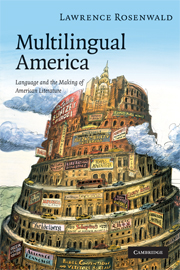Book contents
- Frontmatter
- Contents
- Preface
- Acknowledgments
- Introduction: techniques, methods, theses
- Chapter 1 Cooper's The Last of the Mohicans and the languages of America
- Chapter 2 Alfred Mercier, George W. Cable, and Louisiana French Creole
- Chapter 3 More than an echo, or, English in Yiddish in America
- Chapter 4 “New language fun,” or, on translating multilingual American texts
- Chapter 5 Towards a history of multilingual American literature
- Bibliography
- Index
Chapter 4 - “New language fun,” or, on translating multilingual American texts
Published online by Cambridge University Press: 22 September 2009
- Frontmatter
- Contents
- Preface
- Acknowledgments
- Introduction: techniques, methods, theses
- Chapter 1 Cooper's The Last of the Mohicans and the languages of America
- Chapter 2 Alfred Mercier, George W. Cable, and Louisiana French Creole
- Chapter 3 More than an echo, or, English in Yiddish in America
- Chapter 4 “New language fun,” or, on translating multilingual American texts
- Chapter 5 Towards a history of multilingual American literature
- Bibliography
- Index
Summary
Don Luis told me that one could not translate the bilingual text, because all one could do was to translate from one language to another all over again. I disagreed gently, because I was interested in how the work would turn out.
– Rolando HinojosaIn a broad sense, translation is the central topic of this book. In a narrower sense it has so far been in the background, and needs to be brought forward and considered explicitly. First and most practically, English is the dominant (though not the official) language of multilingual America; non-anglophone works of American literature that vividly represent language encounters will have to be translated into English if they are to matter to most American readers and students of American literature, and how they are translated will affect how they are read. Second, asking how to translate such works, in general and in particular into English, opens up some interesting questions. Translation theory has not dealt extensively with the translation of multilingual texts, nor very rigorously. They seem an anomaly, a small cluster on the margins; in fact they are surprisingly abundant, almost constituting a center of their own. Third, for these works as for many others, the question of how to translate becomes a lens of analysis, showing us things about the works that we could not otherwise see. Finally, being translated is part of the life of every important literary work. Traduttore traditore, translators betray.
- Type
- Chapter
- Information
- Multilingual AmericaLanguage and the Making of American Literature, pp. 122 - 145Publisher: Cambridge University PressPrint publication year: 2008

